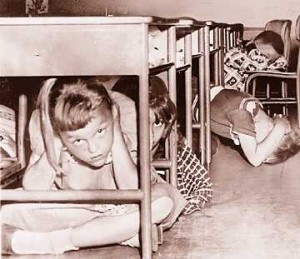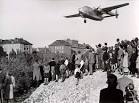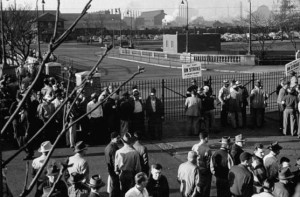By: Jordan Forry
H.W. Brands devotes three chapters of his book, American Dreams, to the early Cold War era. As the primary purpose of his book appears to be to provide an overview of modern American history in narrative form, most of these chapters focus on big picture trends. Brands does an excellent job of conveying the major events that occurred in that time period and the formal policies set out by the government. However, this big picture approach leads to many generalizations, especially regarding the home front. In this essay, I will use information gained from an interview with a woman who lived through the early Cold War (Lois Shaffer), as well as, other primary and secondary sources to both confirm Brands’ observations regarding the home front and also elaborate on parts of Brands’ story which may have been over-generalized.
Brands spends a decent amount of space describing the Berlin blockade by the Soviets and the corresponding airlift conducted by the U.S. in 1948-1949. He describes Truman as being determined to “not be pushed out of Berlin by Soviet pressure” and points out the incredible logistics required to coordinate “Hundreds of American and British cargo planes… landing and taking off as frequently as once per minute.” [1] What is lacking in this analysis of arguably the first major showdown between the U.S.S.R. and the U.S. is the attitudes of Americans on the home front. Lois Shaffer recalls that after following the situation on the radio, she and her husband became impressed with the feat that the U.S. military was able to accomplish, but she was also quick to point out that they did not necessarily follow the progress of the airlift on a day to day basis. [2] Part of the support for the airlifts on the home front undoubtedly came from national pride for what the U.S. could accomplish, but it did help that the U.S. military proclaimed its military prowess openly in the news. One example of this includes a Boston Daily Globe article from 1948 in which The Globe reported on the Air Force’s claim that it had the capacity to continue the airlift operation for as long as public support existed for the program. [3] With guarantees from the military that the U.S. could continue indefinitely with the airlifts, Americans had every reason to be optimistic with and support the airlifts under Truman’s leadership.
Brands also describes the Korean War within a policy-oriented framework that leaves out much of the story from the perspective of the home front. He describes the aggression of North Korea against South Korea as follows: “Communism was on the march and the forces of freedom needed to stop it. Korea was a test; if the United States and its allies exhibited resolve, the fighting might go no farther.” [4] Brands does get around to stating that the war, “grew unpopular,” but fails to further elaborate on the complexities of public opinion. [5] Shaffer, whose brother Lester Degroft fought in Korea, expressed conflicting opinions of the war. On one hand, she recalled that the war almost seemed like a continuation of WWII, being that the country had been at peace for only a few years between the wars. On the other hand, she claims that she and other Americans understood the significance of the war and supported Truman. [6] Others, such as Pierpooli Jr. better delineate the stages of American support and rejection of the war effort. Pierpooli claims that in the early stages of the war, Americans largely supported the war effort, but after intervention by communist China in November of 1950, widespread fear and defeatism crept in. [7] The public further lost confidence in the war effort after President Truman’s attempt to seize the striking steel mills ended in public embarrassment with a Supreme Court repudiation of his actions. [8] In sum, Pierpooli concludes that the Korean War “reflected a house divided. It engendered bitter rhetoric… (and) fostered a poisonous atmosphere of paranoia and fear…”[9] These conflicting stories of initial public support for the War and then partial to total rejection of the effort are lost in Brands’ broad overview of the War.
Another important aspect of life on the home front during the early Cold War was the constant threat and psychological toll of a nuclear attack. Brands suggests that Americans were comforted by the slight, but apparent, military advantage the U.S. held in the early years of the Cold War, but “the reassurance could be no more than fleeting, for the nuclear arms race continued, and the shadow across the American future-and the future of the world-grew ever longer.”[10] This quote from Brands suggests three things: that Americans were in grave danger of nuclear attack, that they accurately sensed this danger, and that they felt fear in response to these facts. However, fear may not have been as prevalent as suggested. Russell Baker recalls that just days after the first atomic bombs exploded over Nagasaki and Hiroshima, he and his mother had exchanged letters in which neither of them “indicated that we even realized anything very extraordinary had happened.” [11] Shaffer recalls that the threat of an atomic attack was always on the back of her mind, but it was not something that consumed her on a day-to-day basis or caused her to lose sleep at night. Rather, it represented a dinner conversation piece depending on the news that night. [12] This general nonchalance is reflected by the fact that polls during this period only showed a little more than half of all Americans (53%) thought there was a good or fair chance that their hometowns would be attacked. [13] This means that half of all Americans believed they faced only slim odds of experiencing a nuclear disaster, which seems to be a far less dire situation than which Brands paints. Perhaps individuals instead, as Elaine May hypothesizes, put their efforts into building a family, instead of fearing for the future, as the “home represented a source of meaning and security in a world run amok.” [14]

Students demonstrating “Duck and Cover” Circa 1950. Photo Credit: http://undergroundbombshelter.com/news/w….
On the other hand, Americans did have things to fear and did take actions and altered their lifestyles in significant ways to combat the threat of a nuclear attack. For example, Shaffer remembers schools started to have bomb drills and the government encouraged citizens to consider building bomb shelters, even as she and her neighbors did not build them for lack of money.[15] The bomb drills Shaffer recalls are most likely the “Duck and Cover” program that the U.S. government started running in schools that instructed kids to seek shelter under desks, chairs, or against walls whenever they heard an explosion or saw the flash of the bomb. [16] Also, while Shaffer never built a bomb shelter for her family, some cities, such as New York, petitioned the federal government for money to construct such facilities. In 1950, the City Planning Commissioners from New York City determined the cost of building bomb shelters for New York City would total $450,000,000, and that this project represented something “that is practical, can be completed within a reasonable time, and that is needed in view of the world situation.” [17] Finally, in addition to bomb shelters, some individuals also took steps to ensure that they and their families would be ready to survive a nuclear disaster after the initial blast. This would require having enough food stocked to last through the apocalypse. As more and more people sought to prepare themselves for the worst, guides, such as “Grandma’s Pantry to Nuclear Survival,” arose that provided recommendations for how much water, food, and other essentials to have on hand.[18]
In conclusion, life on the home front during the early Cold War was complicated. One of the drawbacks of writing a seventy year narrative of U.S. history like Brands does is it forces one to focus on the overarching themes and policies in American history and can cause one to overlook the complexities of certain times or the effects of certain historical events on the lives of ordinary Americans. By exploring other primary sources from the time, by interviewing a historical witness of the period, and by analyzing other secondary sources, a more complex picture of the U.S. home front during the early Cold War develops; one in which people are allowed to have differences in opinion and experiences. Through this analysis, it becomes evident that although the Cold War weighed heavily on everyone’s minds, it did not completely consume the day-to-day lives of all Americans. In these ways, life on the home front was more complicated than Brands is able to convey in American Dreams.
Footnotes:
1. H. W. Brands, The United States Since 1945: American Dreams (New York: Penguin Books, 2010), 40-41.
2. Interview with Lois Shaffer, Spring Grove, PA, March 12, 2015. (Interview was conducted face-to-face, but not recorded. As such, all material used in the paper is a close approximation of responses given unless quotations are provided).
3. Carlyle Holt, “Lemay Declares U.S. can Maintain Berlin Airlift as Long as Necessary,”Daily Boston Globe, September 14, 1948 (Pro-Quest).
4. Brands, American Dreams, 56.
5. Ibid., 58.
6. Interview with Lois Shaffer, March 12, 2015.
7. Paul G. Pierpaoli, Jr., “Truman’s Other War: The Battle for the American Home Front, 1950-1953,” OAH Magazine of History 14, no. 3 (2000):16-17 (JSTOR).
8. Ibid., 18.
9. Ibid., 19.
10. Brands, American Dreams, 67.
11. Russell Baker, Growing Up (New York: Penguin Books, 1982), 292.
12. Interview with Lois Shaffer, March 12, 2015.
13. Elaine Tyler May, Homeward Bound: American Families in the Cold War Era (New York: Basic Books, 2008), 25 (eBook).
14. Ibid., 26-27.
15. Interview with Lois Shaffer, March 12, 2015.
16. “Duck and Cover,” U.S. Federal Civil Defense Administration Video,9:15 (1951), posted by Archer Productions Incorporated, 2004. https://archive.org/details/DuckandC1951.
17. “Atomic Bomb Shelters?,” The New York Times, August 7, 1950 (Pro-Quest).
18. May, Homeward Bound, 100-101.



Leave a Reply